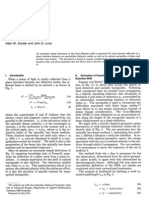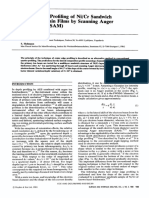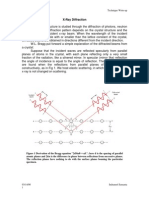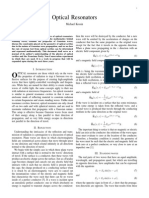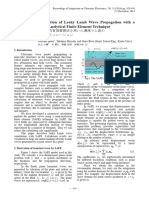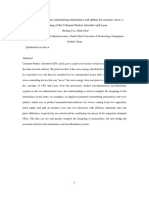2ooo Testefore
2ooo Testefore
Uploaded by
DanielColoradoGaviriaCopyright:
Available Formats
2ooo Testefore
2ooo Testefore
Uploaded by
DanielColoradoGaviriaCopyright
Available Formats
Share this document
Did you find this document useful?
Is this content inappropriate?
Copyright:
Available Formats
2ooo Testefore
2ooo Testefore
Uploaded by
DanielColoradoGaviriaCopyright:
Available Formats
JOSA COMMUNICATIONS
Communications are short papers. Appropriate material for this section includes reports of incidental research results,
comments on papers previously published, and short descriptions of theoretical and experimental techniques.
Communications are handled much the same as regular papers. Proofs are provided.
On the zero-thickness model of diffractive
optical elements
Markus Testorf
University of Massachusetts-Lowell, Department of Electrical and Computer Engineering, One University Avenue,
Lowell, Massachusetts 01854
Received October 28, 1999; accepted March 10, 2000
In a recent paper [J. Opt. Soc. Am. A 16, 113 (1999)] a thin-element approximation of diffractive optical ele-
ments was used to describe diffraction of oblique incident wave fronts. This expression motivated by a ray
optical analysis is shown to be incorrect. I discuss how the thin-element approximation can be generalized to
arbitrary diffraction geometries. This includes an intuitive interpretation of the results. © 2000 Optical So-
ciety of America [S0740-3232(00)01406-X]
OCIS codes: 050.1940, 050.1970.
This communication was prompted by several private reference plane z 0 to the diffractive surface and of the
communications, as well as by a recent publication on the projections BA and DC from the surface back to the ref-
comparison between rigorous and approximate diffraction erence plane. The choice of z 0 corresponds to a constant
models.1 The problem that is addressed here is the ap- phase in the transmission function, and Eq. (1) can be ob-
proximation of diffractive optical elements (DOE’s) as tained for z 0 ⫽ 0.
thin diffraction screens, which is valid for paraxial wave If the angle between the direction of the incident wave
fronts only.2 This approximation is referred to as the and the optical axis z exceeds the paraxial domain, the
thin-element approximation (TEA), or zero-thickness phase modulation changes. A recent publication1 derives
model. In diffractive optics this model is also termed sca- the modified expression for the phase modulation by cal-
lar approximation.1 In particular, how the phase-only culating the optical path-length distribution from projec-
transmission function relates to the profile of a surface- tions A 1 BA 2 and C 1 DC 2 , respectively. This yields a
relief DOE in the case of an oblique incident wave front is phase distribution that is characterized by substitution of
discussed. ⌳ ⫽ ⫺2/cos ␣ into Eq. (1). Although this idea on how the
The surface-relief structure can be described as a depth TEA has to be modified in the case of an oblique incidence
profile z ⫽ h(x), with x and z being the lateral and lon- seems to be rather widespread, it is incorrect neverthe-
gitudinal coordinates, respectively. The TEA yields the less.
corresponding transmission function as a phase-only A formal way to derive the correct expression for the
modulation of the incident complex amplitude distribu- TEA is provided by the Born approximation (BA) of
tion. The phase distribution is given as surface-relief elements.3,4 For reflecting boundaries, an
equivalent expression is provided by the extended Kirch-
2
共 x兲 ⫽ h 共 x兲 ⌳, (1) hoff approximation (EKA).5 Unlike the Kirchhoff ap-
proximation for reflecting boundaries,6 the EKA does not
assume surface fields to vanish in geometrical shadow re-
with being the wavelength of the monochromatic signal.
gions. Both the BA and the EKA are not limited to
For dielectric interfaces and an incident plane wave
paraxial wave fronts. In fact, the TEA can be derived as
propagating along z, one finds ⌳ ⫽ n 1 ⫺ n 2 , where n 1
a small-angle approximation of the BA,3 which makes it
and n 2 are the refractive indices on either side of the in-
well suited to explore the validity of the TEA. Assuming
terface. For reflecting surfaces it is ⌳ ⫽ ⫺2, where the
a two-dimensional geometry and a plane-wave incident at
sign accounts for the fact that a larger height h causes a
an angle ␣, BA and EKA predict the plane-wave spectrum
smaller phase delay. Equation (1) can be interpreted as
of the diffracted wave as
a projection of the surface profile scaled with the optical
path-length difference in wavelength units.
In Fig. 1 the geometry of a reflecting surface with two
different modulation depths h 1 and h 2 is shown. The
phase distribution with which an incident wave parallel ũ 共 兲 ⫽ C 关  共 i 兲 ,  兴 冕
⫺⬁
⬁
exp(⫺i2 兵 关  ⫺  共 i 兲 兴 h 共 x, y 兲
to the z coordinate is modulated can be calculated as the
optical path length of the projections AB and CD from a ⫹ 关 ⫺ 共 i 兲 兴 x 其 )d x, (2)
0740-3232/2000/061132-02$15.00 © 2000 Optical Society of America
JOSA Communications Vol. 17, No. 6 / June 2000/ J. Opt. Soc. Am. A 1133
provide the correct expression. To this end, it is impor-
tant to realize that the TEA provides a transmission func-
tion that allows calculation of the diffracted field from a
pointwise multiplication with the incident wave front.
For instance, to obtain the diffracted wave at point A the
incident wave at point A is multiplied with a transmission
function evaluated at the same point. By calculation of
the path A 1 BA 2 , in Fig. 1, however, the diffracted wave
at point A2 is calculated from the incident field at point
A1, which is not in agreement with the concept of a trans-
mission function. Instead of analyzing the propagation
of optical rays, one has to consider the corresponding
plane wave propagating along A 1 BA 2 . The lines AP 1
and AP 2 mark planes of constant phase of the incident
and the reflected wave, respectively, both intersecting
with point A. Therefore the phase delay at point A is
given as the optical path length necessary to propagate
the wave front from P 1 to B and from B to P 2 . This
again yields the correct result ⌳ ⫽ ⫺2 cos ␣.
In summary, I have generalized the relation between
Fig. 1. Geometry of diffraction at a reflecting step profile.
the profile of surface-relief DOE’s and the phase modula-
tion predicted by the TEA. An analysis based on the
where the factor C 关  ( i ) ,  兴 depends on the type of diffrac-
EKA shows that a simple evaluation of the ray optical
tive structure. The incident wave is specified by a spatial
path-length distribution may lead to incorrect results. It
frequency ( i ) ⫽ sin ␣/ and a propagation constant  ( i )
should be pointed out that the use of the correct expres-
⫽ cos ␣/. Equally, each diffracted plane-wave compo-
sion for the TEA does not only influence the accuracy of
nent is described by a frequency and a propagation con-
the predicted diffraction pattern. More significant, if the
stant . To retrieve the TEA from Eq. (2), we assume the
thin-element model is used to calculate the required etch
propagation constant to be equal for all diffraction angles,
depth for a photolithographic fabrication of DOE’s, it di-
i.e., 关  ⫺  ( i ) 兴 ⬇ ⫺2  ( i ) for reflecting surfaces. Equation
rectly impacts the performance of the element and its
(2) can be recognized as the Fourier transformation of a
function in an optical system.
phase-only function. A comparison of this phase function
with Eq. (1) yields The author can be reached at the address on the title
⌳ ⫽ ⫺2 cos ␣ , (3) page or by telephone at 978-934-3306, by fax at 978-934-
3027, or by e-mail at testorf@galileo.eng.uml.edu.
where we have assumed  ⬍ 0. A similar analysis can
(i)
be carried out, if the diffractive structure changes the ori-
entation of the main propagation direction, for instance,
by use of a high-frequency diffraction grating. If all dif-
fracted plane-wave components propagate with a direc- REFERENCES
tion that is well approximated by  ⬇ cos ␣⬘/ we find 1. J. M. Bendickson, E. N. Glytsis, and T. K. Gaylord, ‘‘Metal-
lic surface-relief on-axis and off-axis focusing diffractive cy-
⌳ ⫽ ⫺共 cos ␣ ⬘ ⫹ cos ␣ 兲 . (4) lindrical mirrors,’’ J. Opt. Soc. Am. A 16, 113–130 (1999).
2. B. E. A. Saleh and M. C. Teich, Fundamentals of Photonics
Finally, the thin-element approximation for dielectric (Wiley, New York, 1991), Chap. 2, pp. 55–63.
surface profiles is derived by appreciating that the propa- 3. W. Singer and K.-H. Brenner, ‘‘Transition of the scalar field
gation constants are  ( i ) ⫽ n 1 cos ␣/ and  ⫽ n 2 cos ␣⬘/ at a surface in the generalized Kirchhoff diffraction theory,’’
before and behind the interface, respectively. The corre- J. Opt. Soc. Am. A 12, 1913–1919 (1995).
sponding phase distribution is defined by 4. M. Testorf, ‘‘Perturbation theory as a unified approach to
design diffractive optical elements,’’ J. Opt. Soc. Am. A 16,
⌳ ⫽ n 1 cos ␣ ⫺ n 2 cos ␣ ⬘ . (5) 1115–1123 (1999).
5. P. C. Waterman, ‘‘Scattering by periodic surfaces,’’ J.
Note that essentially the same relation for the phase Acoust. Soc. Am. 57, 791–802 (1975).
modulation was derived independently for use in a wide- 6. A. Ishimaru, Electrodynamic Wave Propagation, Radiation,
angle beam propagation method7 and can be found in and Scattering (Prentice-Hall, Englewood Cliffs, N. J.,
1991), Chap. 6.3, pp. 156–157.
textbooks as well.2 7. K.-H. Brenner and W. Singer, ‘‘Light propagation through
It seems worthwhile to discuss why the heuristic deri- microlenses: a new simulation method,’’ Appl. Opt. 32,
vation from the projection of the ray optical path does not 4984–4988 (1993).
You might also like
- ReSA B48 AUD Final PB Exam Questions Answers and SolutionsDocument18 pagesReSA B48 AUD Final PB Exam Questions Answers and SolutionsGab GabNo ratings yet
- Goos HanchenDocument3 pagesGoos HanchenJoel PaddockNo ratings yet
- Diffraction Theory of Electromagnetic WavesDocument9 pagesDiffraction Theory of Electromagnetic WavesVinland100% (1)
- Copia de General Transfer-Matrix Method For InterferenceDocument10 pagesCopia de General Transfer-Matrix Method For InterferenceDanielColoradoGaviriaNo ratings yet
- India Hair Care Market Outlook, 2023Document8 pagesIndia Hair Care Market Outlook, 2023Bonafide ResearchNo ratings yet
- App Opt 91Document2 pagesApp Opt 91hselim_1No ratings yet
- Introduction To Paraxial Geometrical OpticsDocument13 pagesIntroduction To Paraxial Geometrical OpticsJNo ratings yet
- Tremaine 1996 0408Document5 pagesTremaine 1996 0408Particle Beam Physics LabNo ratings yet
- ABIshizukaDocument3 pagesABIshizukaRik ChattopadhyayNo ratings yet
- Fibre PPT 3Document20 pagesFibre PPT 3Miraj SheikhNo ratings yet
- Dr. Yahya AliDocument14 pagesDr. Yahya AliSakena AbbasNo ratings yet
- SLT GDocument4 pagesSLT GrhythmNo ratings yet
- Rosenzweig 1998 0154Document19 pagesRosenzweig 1998 0154Particle Beam Physics LabNo ratings yet
- PH1 ProbSet 5Document2 pagesPH1 ProbSet 5akshat shNo ratings yet
- Rohini 97661964437Document9 pagesRohini 97661964437aswinvirat84No ratings yet
- Optical TweezersDocument22 pagesOptical TweezersconcebaysNo ratings yet
- Transition Radiation Emitted An Ultrarelativistic Particle Crossing A Curved Interface Between MediaDocument4 pagesTransition Radiation Emitted An Ultrarelativistic Particle Crossing A Curved Interface Between MediarijurahmanNo ratings yet
- Crater Edge Profiling Ni/Cr Sandwich Multilayer Thin Films by Scanning Auger Microscopy (SAM)Document4 pagesCrater Edge Profiling Ni/Cr Sandwich Multilayer Thin Films by Scanning Auger Microscopy (SAM)LizetForeroEspinelNo ratings yet
- Hartmann 1993Document10 pagesHartmann 1993Eloy MartinsNo ratings yet
- Reflection From A Periodically Perforated Plane Using A Subsectional PDFDocument8 pagesReflection From A Periodically Perforated Plane Using A Subsectional PDFTalha ÇalışNo ratings yet
- Review Letters Of: PhysicalDocument3 pagesReview Letters Of: PhysicalWilant GomariNo ratings yet
- Acousto Optics Modulator 1Document9 pagesAcousto Optics Modulator 1SURESH SURAGANINo ratings yet
- XRD TheoryDocument7 pagesXRD TheoryAdarta Muh100% (1)
- 2D Pattern Matching With Adaptive Photodetectors: Korneev, S. StepanovDocument7 pages2D Pattern Matching With Adaptive Photodetectors: Korneev, S. StepanovAngel CoronelNo ratings yet
- Analysis of Optical Elements With The Local Plane-Interface ApproximationDocument10 pagesAnalysis of Optical Elements With The Local Plane-Interface ApproximationDanielColoradoGaviriaNo ratings yet
- Band Gap Analysis Uv Visible Spectroscopy An54685 enDocument4 pagesBand Gap Analysis Uv Visible Spectroscopy An54685 enAsanka RoshanNo ratings yet
- X-Rays Some Basics (Optional Reading)Document7 pagesX-Rays Some Basics (Optional Reading)Sandy emulatorNo ratings yet
- Of of 2nd 1990: p2 p2 ZoDocument3 pagesOf of 2nd 1990: p2 p2 ZoNilesh NagraleNo ratings yet
- Re8ection K.: X-Ray Transmission Surfaces D. GDocument9 pagesRe8ection K.: X-Ray Transmission Surfaces D. Gcristhian alvarezNo ratings yet
- Optical Resonators: Michael KossinDocument5 pagesOptical Resonators: Michael KossinMichael KossinNo ratings yet
- lecture note for electrodynamics courseDocument6 pageslecture note for electrodynamics courseGetachew TizazuNo ratings yet
- Coherent Transition Radiation From A Helically Microbunched Electron BeamDocument6 pagesCoherent Transition Radiation From A Helically Microbunched Electron BeamParticle Beam Physics LabNo ratings yet
- IlluminationDocument25 pagesIlluminationNikhilesh MohitNo ratings yet
- Acustica: Light Diffraction by Ultrasonic GratingsDocument8 pagesAcustica: Light Diffraction by Ultrasonic GratingsRustin PurplemanNo ratings yet
- Wave OptDocument13 pagesWave OptEdney MeloNo ratings yet
- Dokumen - Tips - Ray Tube Integration in Shooting and Bouncing Ray MethodDocument4 pagesDokumen - Tips - Ray Tube Integration in Shooting and Bouncing Ray MethodAsd DsaNo ratings yet
- 1996-03-A Comparison of Theoretical and Empirical Reflection Coefficients For Typical Exterior Wall Surfaces in A Mobile Radio EnvironmentDocument11 pages1996-03-A Comparison of Theoretical and Empirical Reflection Coefficients For Typical Exterior Wall Surfaces in A Mobile Radio EnvironmentabdelNo ratings yet
- ao-30-305-Cotteverte-Jones Matrices of A Tilted Plate For Gaussian BeamsDocument7 pagesao-30-305-Cotteverte-Jones Matrices of A Tilted Plate For Gaussian BeamsJean-Charles CotteverteNo ratings yet
- Myers InterfDocument18 pagesMyers InterfAnonymous FGY7goNo ratings yet
- Analysis of Longitudinal Slots in Rectangular WaveguidesDocument7 pagesAnalysis of Longitudinal Slots in Rectangular WaveguidesnguyenhanammtaNo ratings yet
- Multiple Reflections in An Approximately Parallel PlateDocument5 pagesMultiple Reflections in An Approximately Parallel PlateVictor PrikhodkoNo ratings yet
- Topological Nature of Radiation Asymmetry in Bilayer MetagratingsDocument17 pagesTopological Nature of Radiation Asymmetry in Bilayer Metagratingsdjbdc9qpc4No ratings yet
- Opto Electronics NotesDocument40 pagesOpto Electronics NotesDhamodharan Srinivasan100% (1)
- Simulation of Leaky Lamb Wave Propagation With A Semi-Analytical Finite Element TechniqueDocument2 pagesSimulation of Leaky Lamb Wave Propagation With A Semi-Analytical Finite Element TechniqueEnes şavlıNo ratings yet
- Guided Wave Study of Asymmetric Planner Slab Dielectric Optical WaveguideDocument3 pagesGuided Wave Study of Asymmetric Planner Slab Dielectric Optical WaveguidebhaktameltNo ratings yet
- Complementary Frequency Selective SurfacesDocument7 pagesComplementary Frequency Selective SurfacesBruno SátiroNo ratings yet
- Get The Basics Right Jacobian Conversion of Wavelength and Energy PDFDocument3 pagesGet The Basics Right Jacobian Conversion of Wavelength and Energy PDFNitika GuptaNo ratings yet
- TutorialDocument12 pagesTutorialSougata HalderNo ratings yet
- Antenas de EspiralDocument3 pagesAntenas de EspiralJOSE JULIANNo ratings yet
- Tomographic Imaging With Diffracting Sources 203Document71 pagesTomographic Imaging With Diffracting Sources 203IgorNo ratings yet
- X-Ray Diffraction (XRD)Document4 pagesX-Ray Diffraction (XRD)Shaba ShaikhNo ratings yet
- Longitudinal Beam-Beam Effects in Circular Colliders: E NC'P' (F) Ax + A, 2/q+) 2E 'Document3 pagesLongitudinal Beam-Beam Effects in Circular Colliders: E NC'P' (F) Ax + A, 2/q+) 2E 'Particle Beam Physics LabNo ratings yet
- Diss 6 10Document5 pagesDiss 6 10A GNo ratings yet
- Polar EigenstatesDocument11 pagesPolar EigenstatesPeter MuysNo ratings yet
- Angular-Asymmetric Transmitting Metasurface and Splitter For Acoustic Wave: A Combining of The Coherent Perfect Absorber and LaserDocument14 pagesAngular-Asymmetric Transmitting Metasurface and Splitter For Acoustic Wave: A Combining of The Coherent Perfect Absorber and LaserCarlos FazNo ratings yet
- 3518 1 OnlineDocument8 pages3518 1 OnlineAkash RoyNo ratings yet
- Partially Reflecting Sheet Arrays-LwtDocument6 pagesPartially Reflecting Sheet Arrays-LwtArchNo ratings yet
- Antenna Theory and Design: Presented By, Chetan.B.V 1 Sem Mtech (DECS) Dept of Ece MCEDocument23 pagesAntenna Theory and Design: Presented By, Chetan.B.V 1 Sem Mtech (DECS) Dept of Ece MCEChetan B VNo ratings yet
- Phys2090 Optical Physics Laboratory - Fresnel Zone Plate: CautionDocument6 pagesPhys2090 Optical Physics Laboratory - Fresnel Zone Plate: Cautionsiddharth kathaitNo ratings yet
- Mohara M 1980Document6 pagesMohara M 1980React PatrolNo ratings yet
- 1970 A Survey of Clear-Air Propagation Effects Relevant To Optical CommunicationsDocument23 pages1970 A Survey of Clear-Air Propagation Effects Relevant To Optical Communicationsrahulec79No ratings yet
- Emittance Preservation in Plasma-Based Accelerators With Ion MotionDocument9 pagesEmittance Preservation in Plasma-Based Accelerators With Ion MotionaliceNo ratings yet
- Intensity of Electromagnetic Waves as a Function of Frequency, Source Distance and Aperture AngleFrom EverandIntensity of Electromagnetic Waves as a Function of Frequency, Source Distance and Aperture AngleNo ratings yet
- Diferencia Entre Coherencia y DifraccionDocument7 pagesDiferencia Entre Coherencia y DifraccionDanielColoradoGaviriaNo ratings yet
- Coherence and HolographyDocument9 pagesCoherence and HolographyDanielColoradoGaviriaNo ratings yet
- Analysis of Optical Elements With The Local Plane-Interface ApproximationDocument10 pagesAnalysis of Optical Elements With The Local Plane-Interface ApproximationDanielColoradoGaviriaNo ratings yet
- Introduction Bash Shell ScriptingDocument7 pagesIntroduction Bash Shell ScriptingDanielColoradoGaviriaNo ratings yet
- Sinelnik 2017Document10 pagesSinelnik 2017DanielColoradoGaviriaNo ratings yet
- Lamp Server: Phd. Alcides Montoya Canola, Est. Carlos Andres Ballesteros Universidad Nacional de Colombia - Sede MedellinDocument7 pagesLamp Server: Phd. Alcides Montoya Canola, Est. Carlos Andres Ballesteros Universidad Nacional de Colombia - Sede MedellinDanielColoradoGaviriaNo ratings yet
- FTP Server: Phd. Alcides Montoya Canola, Est. Carlos Andres Ballesteros Universidad Nacional de Colombia - Sede MedellinDocument5 pagesFTP Server: Phd. Alcides Montoya Canola, Est. Carlos Andres Ballesteros Universidad Nacional de Colombia - Sede MedellinDanielColoradoGaviriaNo ratings yet
- Dns Server: Phd. Alcides Montoya Canola, Est. Carlos Andres Ballesteros Universidad Nacional de Colombia - Sede MedellinDocument4 pagesDns Server: Phd. Alcides Montoya Canola, Est. Carlos Andres Ballesteros Universidad Nacional de Colombia - Sede MedellinDanielColoradoGaviriaNo ratings yet
- Dynamic Host Configuration ProtocolDocument6 pagesDynamic Host Configuration ProtocolDanielColoradoGaviriaNo ratings yet
- Chapter 8 Quizbowl AnswerDocument68 pagesChapter 8 Quizbowl Answerdiane camansagNo ratings yet
- Siemens-Healthineers OEM Data-Sheet Ray-14 2021-07Document5 pagesSiemens-Healthineers OEM Data-Sheet Ray-14 2021-07eduardoNo ratings yet
- Sabe/Aep Buenos Aires, Argentina: El Palomar 8 DepartureDocument1 pageSabe/Aep Buenos Aires, Argentina: El Palomar 8 Departureapi-15821808No ratings yet
- The Use of Addie Model For Designing Blended Learning Application at Vocational Colleges in MalaysiaDocument14 pagesThe Use of Addie Model For Designing Blended Learning Application at Vocational Colleges in Malaysiafender 87No ratings yet
- AHIX241 Alexander The Great Essay 1 44546335Document4 pagesAHIX241 Alexander The Great Essay 1 44546335Dani GormanNo ratings yet
- Keyes - Funduino Uno and Nano Multi Purpose Shield V3Document5 pagesKeyes - Funduino Uno and Nano Multi Purpose Shield V3David FernándezNo ratings yet
- Certified Credit Research Analyst (CCRA) : Syllabus Section 1Document2 pagesCertified Credit Research Analyst (CCRA) : Syllabus Section 1Aniket VarshneyNo ratings yet
- TCP:IP Reference ModelDocument12 pagesTCP:IP Reference Modelsocekay372No ratings yet
- Ncsimul Solutions Optitool enDocument4 pagesNcsimul Solutions Optitool enluli pejaNo ratings yet
- HVAC System Design and Installation ProceduresDocument24 pagesHVAC System Design and Installation ProceduresMiguelAzucena100% (5)
- What Are The Objectives of ResearchDocument5 pagesWhat Are The Objectives of Researchg mujtabaNo ratings yet
- Marcus v. Epps Et Al - Document No. 6Document1 pageMarcus v. Epps Et Al - Document No. 6Justia.comNo ratings yet
- LEED Summary SheetDocument21 pagesLEED Summary SheetJadedT100% (4)
- Kuswata 2006 Enam Dekade Penelitian EkologiDocument46 pagesKuswata 2006 Enam Dekade Penelitian EkologiahasanlukmanNo ratings yet
- Letter of Intent - TemplateDocument3 pagesLetter of Intent - TemplateHixodiyNo ratings yet
- HSE Management Standards Indicator ToolDocument3 pagesHSE Management Standards Indicator ToolOllie EvansNo ratings yet
- EHRM in Developing CountriesDocument15 pagesEHRM in Developing CountriescannaizerNo ratings yet
- Chavez vs. Court of AppealsDocument9 pagesChavez vs. Court of Appealsvince005No ratings yet
- Chamblee ManorDocument35 pagesChamblee ManorZachary HansenNo ratings yet
- Gsa 8XGSM 85 (A)Document80 pagesGsa 8XGSM 85 (A)Eric HenriqueNo ratings yet
- CMAX Operation Manual of SC Building Hoist 2015Document106 pagesCMAX Operation Manual of SC Building Hoist 2015Jameela Perez100% (2)
- PDF 24Document3 pagesPDF 24Nelenor BaronNo ratings yet
- 24 Questions by The BookDocument5 pages24 Questions by The BookmissberbaevaNo ratings yet
- Digital Signature Certificate User Manual: WWW - Taxgenius.co - inDocument11 pagesDigital Signature Certificate User Manual: WWW - Taxgenius.co - inR G InstituteNo ratings yet
- Main Hoon Na Guitar Tab, Leads, Solo and Notes PDFDocument2 pagesMain Hoon Na Guitar Tab, Leads, Solo and Notes PDFARYAN RATHORENo ratings yet
- Furniture Packaging SpecificationsDocument4 pagesFurniture Packaging SpecificationsCristina Zuluaga PenagosNo ratings yet
- For EngineeringDocument4 pagesFor EngineeringDraw with JustineNo ratings yet
- Case StudyDocument11 pagesCase StudyGerald ManlangitNo ratings yet

